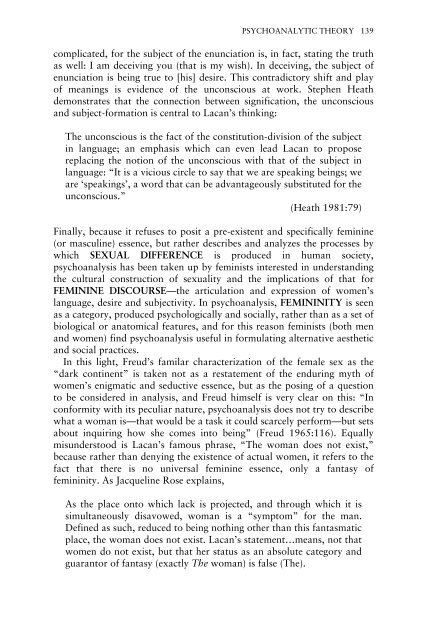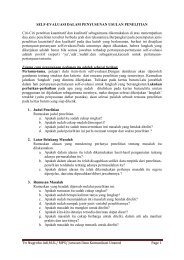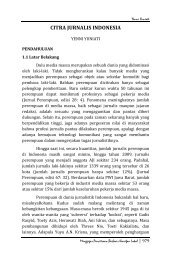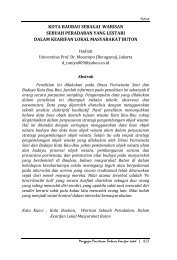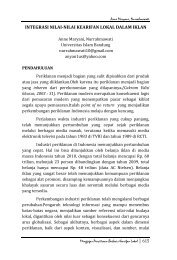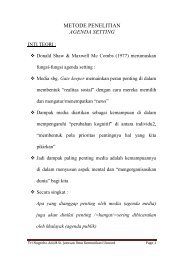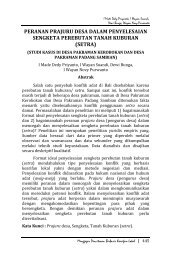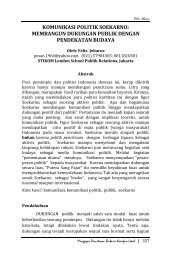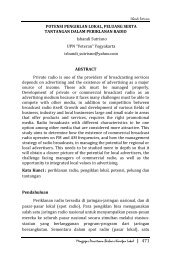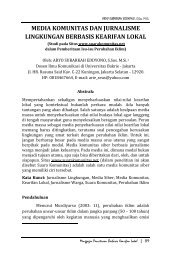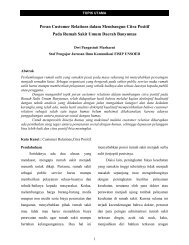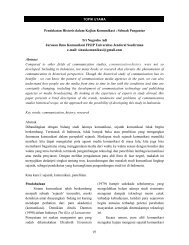New Vocabularies in Film Semiotics
New Vocabularies in Film Semiotics
New Vocabularies in Film Semiotics
You also want an ePaper? Increase the reach of your titles
YUMPU automatically turns print PDFs into web optimized ePapers that Google loves.
PSYCHOANALYTIC THEORY 139<br />
complicated, for the subject of the enunciation is, <strong>in</strong> fact, stat<strong>in</strong>g the truth<br />
as well: I am deceiv<strong>in</strong>g you (that is my wish). In deceiv<strong>in</strong>g, the subject of<br />
enunciation is be<strong>in</strong>g true to [his] desire. This contradictory shift and play<br />
of mean<strong>in</strong>gs is evidence of the unconscious at work. Stephen Heath<br />
demonstrates that the connection between signification, the unconscious<br />
and subject-formation is central to Lacan’s th<strong>in</strong>k<strong>in</strong>g:<br />
The unconscious is the fact of the constitution-division of the subject<br />
<strong>in</strong> language; an emphasis which can even lead Lacan to propose<br />
replac<strong>in</strong>g the notion of the unconscious with that of the subject <strong>in</strong><br />
language: “It is a vicious circle to say that we are speak<strong>in</strong>g be<strong>in</strong>gs; we<br />
are ‘speak<strong>in</strong>gs’, a word that can be advantageously substituted for the<br />
unconscious.”<br />
(Heath 1981:79)<br />
F<strong>in</strong>ally, because it refuses to posit a pre-existent and specifically fem<strong>in</strong><strong>in</strong>e<br />
(or mascul<strong>in</strong>e) essence, but rather describes and analyzes the processes by<br />
which SEXUAL DIFFERENCE is produced <strong>in</strong> human society,<br />
psychoanalysis has been taken up by fem<strong>in</strong>ists <strong>in</strong>terested <strong>in</strong> understand<strong>in</strong>g<br />
the cultural construction of sexuality and the implications of that for<br />
FEMININE DISCOURSE—the articulation and expression of women’s<br />
language, desire and subjectivity. In psychoanalysis, FEMININITY is seen<br />
as a category, produced psychologically and socially, rather than as a set of<br />
biological or anatomical features, and for this reason fem<strong>in</strong>ists (both men<br />
and women) f<strong>in</strong>d psychoanalysis useful <strong>in</strong> formulat<strong>in</strong>g alternative aesthetic<br />
and social practices.<br />
In this light, Freud’s familar characterization of the female sex as the<br />
“dark cont<strong>in</strong>ent” is taken not as a restatement of the endur<strong>in</strong>g myth of<br />
women’s enigmatic and seductive essence, but as the pos<strong>in</strong>g of a question<br />
to be considered <strong>in</strong> analysis, and Freud himself is very clear on this: “In<br />
conformity with its peculiar nature, psychoanalysis does not try to describe<br />
what a woman is—that would be a task it could scarcely perform—but sets<br />
about <strong>in</strong>quir<strong>in</strong>g how she comes <strong>in</strong>to be<strong>in</strong>g” (Freud 1965:116). Equally<br />
misunderstood is Lacan’s famous phrase, “The woman does not exist,”<br />
because rather than deny<strong>in</strong>g the existence of actual women, it refers to the<br />
fact that there is no universal fem<strong>in</strong><strong>in</strong>e essence, only a fantasy of<br />
fem<strong>in</strong><strong>in</strong>ity. As Jacquel<strong>in</strong>e Rose expla<strong>in</strong>s,<br />
As the place onto which lack is projected, and through which it is<br />
simultaneously disavowed, woman is a “symptom” for the man.<br />
Def<strong>in</strong>ed as such, reduced to be<strong>in</strong>g noth<strong>in</strong>g other than this fantasmatic<br />
place, the woman does not exist. Lacan’s statement…means, not that<br />
women do not exist, but that her status as an absolute category and<br />
guarantor of fantasy (exactly The woman) is false (The).


